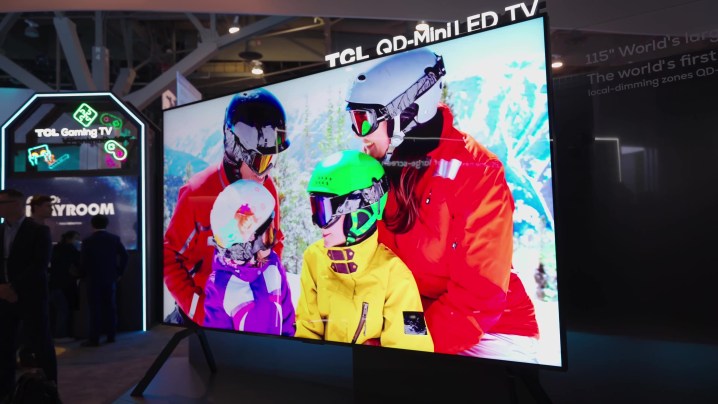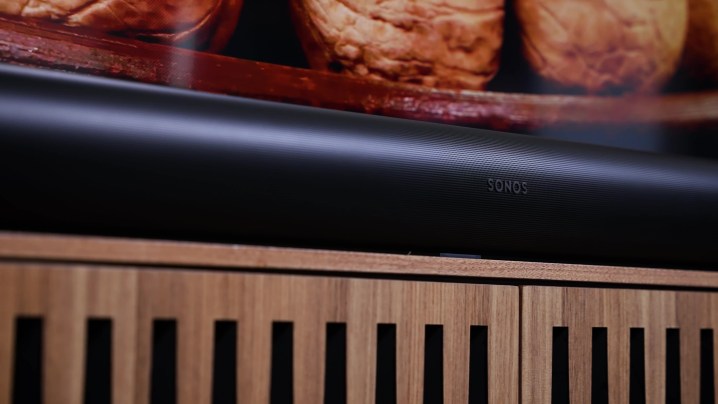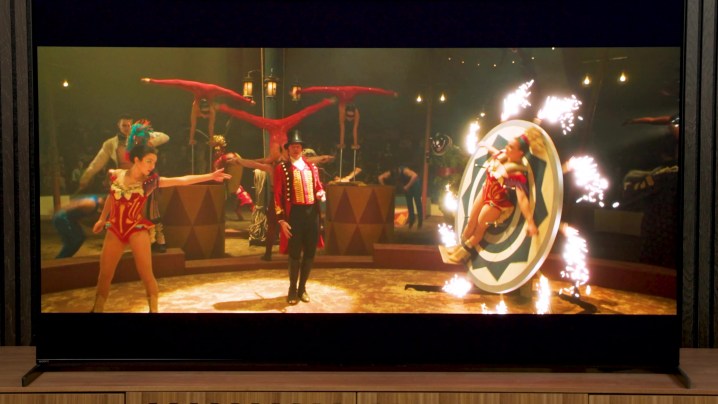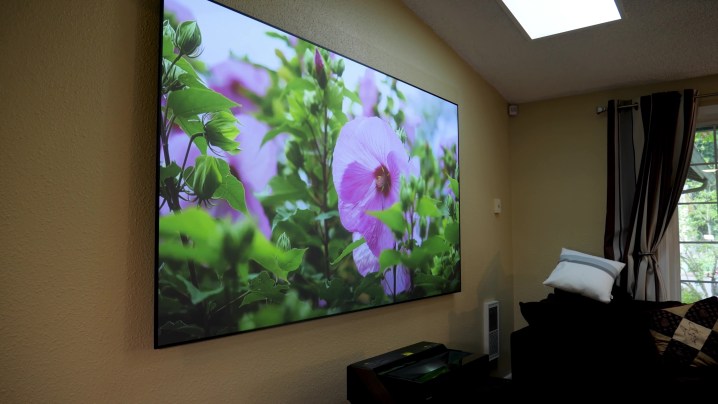This installment of You Asked is a projector-heavy special. There is no better time to do this, given some of the massive TV screen sizes we’re seeing these days, along with falling prices on those massive screen sizes.
Big TV vs. projector

With all these huge screens we saw announced at CES, do you think projectors are on the way out?
A related question came from Sayeed, who said: Hey Caleb, I was wondering about the new Xgimi projectors. Why don’t you also include projector reviews? The TV reviews are great, but I wonder if I and others should consider a projector for screens that are 100+ inches.
Another comment from one of our CES coverage videos asked if there were any projectors at CES and, if so, why they weren’t seeing coverage from anyone around those.
I included all of those questions because they all tie into this one big answer:
First off, never mind all the incredible TVs we saw at CES — I don’t think projectors are on their way out. It’s true that you can get a 98-inch TCL S5 TV for $2,000 right now, which is just absolutely insane. Seriously, if you’re looking for a totally decent big-screen TV, check out that deal because I can hardly believe it’s real.
I bring that up as evidence of the truth that it’s never been less expensive to get a large-screen TV. I remember back in the day that anything above 85 inches was only available from Sharp, and those TVs cost a small mint. Now? Getting a 98-incher is easy.
But projectors still have a place. Because breaking that 100-inch barrier with a TV is still cost-prohibitive. The 110-inch Hisense UX that was just announced, as well as the 115-inch TCL QM89, will no doubt be expensive. I’m thinking somewhere between $15,000 and $20,000.
So, for cost reasons alone, getting a projector setup remains a more economical choice for anything over 100 inches. Ultra short throw projector prices are coming down, and many good options are on the market. I think the fact that large-screen TVs are more affordable now is making folks more comfortable with bigger and bigger screens, and so projectors may become a more popular product category.
But what are big brands thinking? Hisense sells both massive TV screens and laser TVs.
I asked Hisense President David Gold about that at CES, and he said: “We see it as complementary. We see it as there are consumers who want that real cinematic experience and get a little bit of that silver screen experience they would have in a movie theater … so we want to have a product and a solution for that type of consumer, as well as the versatility that we’re now starting to offer in laser as well. So we really see it as complementary and giving the consumer that ability to choose their own adventure in terms of what they want at home.”
Clearly, Hisense feels the market for projectors is still strong as well.
Now, as for why we didn’t see more projector coverage out of CES? We did some. Xgimi was sponsoring writers in Las Vegas (including one of ours), and we swung by their booth for a look-see. Samsung rolled out an updated Premiere 8K projector. LG announced one with a handle.
But the simple fact is there are only so many hours in the day. BenQ, Epson, Hisense, LG, Samsung, Awol, Xgimi, Xiaomi, ForMovie — there are a ton of projector options now, and we just can’t gloss over those any longer.
Projector vs. TV for business applications

Taylor Ulrich writes: Would you recommend a projector or a TV? We’re revamping a conference room in our new office that was previously equipped with an old projector setup. We’d be looking at an 85-inch TV if not a projector. It’s a bright room due to a wall of windows. We use Google Meet videoconferencing, often along with other smart functions like screencasting, YouTube, etc. The budget is $1,500 to $3,000.
Taylor, I’d go with a large-screen TV. And you don’t have to stick to 85 inches. As I just mentioned, there are great deals on 98-inch TVs right now from TCL and Samsung. I’ll add that, with a Google TV especially, built-in Chromecast makes screen sharing easy. There may even be built-in support for Google Meet.
You’ll never have to worry about whether the image is bright enough, and the speakers built into the TV eliminate the need to have powered speakers connected to a projector. So, if you can mount a large-screen TV in that space, I’d say go for it. I’m a big fan of TVs over projectors for business spaces, whenever that is possible. Especially conference rooms.
HDMI switch woes

Carlos Shaw writes: I was wondering if you have a solution for switching between two HDMI eArc signals going to my Sonos Arc soundbar. I have a Samsung 2022 Frame TV and a Xgimi Horizon Pro 4K projector that use the soundbar for sound. There are two HDMI cables that I manually/physically switch and connect/disconnect from the back of the Sonos Arc soundbar depending on which one I want to use.
I’ve purchased about 10 HDMI switches from Amazon, hoping that I can easily toggle each signal, but to my surprise, when I insert an HDMI switch between the Samsung TV or projector and the soundbar, I get no audio at all. Nothing. Am I missing something about how the signals work? I’m fairly tech-savvy, but I can’t seem to figure this one out. HELP!!
So, Carlos, I gave this one a lot of thought and consideration. I’d like to know which HDMI switches you used, just to make absolutely sure they weren’t missing a key feature you might need. In your email, you assured me they supported eARC, but as we know, eARC support does not guarantee HDMI 2.1 support. Nor does it guarantee HDCP 2.3 support. For that reason, I’m curious what you tried. For instance, did you try one of Monoprice’s Blackbird switches? I’d like to know if its 8K 60 switch would work for you. But there’s a chance that even with a switch that supports all the things, you may still run into an issue – and I think this may be at the core of your problem.
Any time you switch from one source to another, your Sonos Arc soundbar needs to complete an HDMI handshake with that source. When this handshake happens, the soundbar learns about what the source is, what it can do, what kind of signal it’s going to send, then includes all this information in the EDID – which stands for Extended Display Identification Data. Included in that handshake is a recognition of HDCP, which stands for High-bandwidth Digital Content Protection.
This handshake must be completed successfully in order for everything to work. My concern is that when you use your switcher to go back and forth between the TV and the projector as sources, that handshake is not getting triggered. Now, ideally, the switch you use would trigger this handshake. It would force it so the EDID was communicated, and if it did, I think everything would work fine. From experience, I know that you may get the video to work, but not the audio.
So, my suggestion for now is to try this: When you make a switch from TV to projector, or vice versa, try turning the TV or projector off, then back on. See if that works. If it doesn’t, try turning the Sonos soundbar off and then back on.
If one of those works, then my suspicion is that the handshake is not taking place after the switch goes from one source to the other, and we need to dig further into what a switch needs to do to force a new handshake and what switches out there will do it for you, if any. I’ll talk to the folks at Monoprice and maybe chat with Jason Dustall at Murideo, who I am sure has a ton of experience with this sort of thing. We’ll get it figured out. But try what I suggested, please get back to me, and we’ll do a follow-up on this in a future article so that everyone else can learn about what happened.
OLED vs. LED for ‘accurate’ cinematic experience

Here’s a question I enjoyed a lot, coming from bcom77 — it’s not exactly a projector question, but projector-adjacent, I guess you could say.
They wrote: We all hear about TVs these days having cinema/filmmaker modes that are supposed to best capture the cinematic experience and creator’s intent. Most TV reviewers/enthusiasts say that OLED TVs are best for capturing this. But shouldn’t LED/mini-LED TVs be best for this as, due to their backlighting, they better mimic a cinema screen and its projector? You don’t get OLED’s perfect blacks and near-infinite contrast ratios in a movie theater no matter how good its setup is, so, therefore, wouldn’t that mean that OLED TVs are not delivering the most “accurate” cinematic experience?
I’m not implying that OLEDs are inferior TVs — as we all know, that’s not true. It’s just a thought I had, and I’d be interested to see what your thoughts on it are.
Interesting thought! I guess I’ll start sharing my thoughts on this by pointing out that there is a lot that’s different between what happens in a cinema and what’s happening on a TV at home.
The trick with projectors and screens is that black levels — or the basis for contrast — come from an absence of any light other than that which the projector is supplying. Now, movie theaters are rarely pitch black, right? You’ve got red exit signs that create light, and there are safety lights so people can see where they are walking. There are a few different light sources in a movie theater, so you never have a complete absence of light.
Still, theaters do a pretty decent job of mitigating how much of the light in those theaters impacts the screen. As a result, you do get pretty decent black levels in a theater. You’re right, though, they aren’t perfectly black like an OLED. But I bet those Hollywood directors sure wish they were.
But I also know many Hollywood directors will talk about not needing more than 200 nits to light a scene properly. Let’s not get into that, though.
In a TV, the filmmaker or Cinema mode is meant to get the color temperature right, the motion cadence correct — i.e., no motion smoothing and solid 24 frames per second (fps) reproduction. And they are supposed to get the luminance right. In other words, the average picture level is meant to coordinate well in a darkened room.
While LCD-based TVs may have black levels that more accurately mirror your experience in a cinema, they also bring other issues to the table that don’t exist in the cinema, like blooming and halo. It’s one thing for the blacks not to be totally black, but it’s another for it to be splotchy around the light source only. In a Ccinema, if the black levels are splotchy, it’s not tied to the content, it’s tied to the ambient light. Does that make sense? There isn’t a straight line of comparison between how an LED-backlit LCD TV behaves and the experience you get from a projector and screen in a cinema.
I think the reason that we like OLED so much is because black is black, yes, but there’s also no halo or blooming involved.
There’s one other differentiating factor we haven’t talked about yet, which leads us nicely to our next question.
Motion clarity: liquid crystal limitations

This comes from Fabrice Teboul. Because their email is a little long, I’m going to have to paraphrase it here:
Fabrice writes: I live in China, and I am looking to upgrade my home theater setup. For now, I have a Xiaomi first-generation 4K laser Ultra short throw projector on an ALR screen linked to a Marantz SR7013 with an Nvidia Shield Pro and computer, an NAS and a PlayStation 4, and a Sony 4K reader.
Fabrice mentions that he wants to upgrade his screen — or display — in his setup and that he got a chance to check out the TCL X955 and Hisense UX 8H – both of which are models special to his region. He then goes on to mention that he wasn’t stoked about the motion blur and lack of definition on those TVs compared to what he’s used to with his projector.
He likes the brightness, contrast, and color of the TVs, but wants better motion clarity and is now wondering if his money is better spent on a brighter projector or a TV, given the motion clarity issues. He’s wondering if the TVs weren’t set up properly where he saw them.
The only way to deal with motion blur on an LCD TV — even with refresh rates of 120 Hz or 240 Hz — is to use motion smoothing processing. The signal you get from your sources is likely 24 or 30 fps most of the time, or 60 fps at best unless you’re gaming and can get legit 120 fps content or higher. That means the TV needs to create fake frames to take advantage of its higher refresh rate. Sometimes they are good at doing that, and sometimes they aren’t. But there’s an inherent limitation to LCD-based TVs that you aren’t stuck with on your laser projector, and it’s why your 60Hz laser projector looks smoother.
It’s the liquid crystal part. The LC in LCD or, for some projectors, it could be LCOS (liquid crystal on silicone).
Your projector is a DLP-type projector. Yes, it uses a laser light source, but the chip that controls and deploys that light is a DLP chip, which stands for digital light projection. And it has a much faster response time than liquid crystal does. So, the advantage your projector has is the DLP chip, which can only work in projection systems. If you had an LCD, 3 LCD, or LCOS projector, you would notice the motion looks very similar to an LCD TV because they use the same fundamental liquid crystal technology to shut the light on and off. Liquid crystal is just slower and more sluggish than DLP.
That is at the heart of what you are noticing. And, frankly, DLP and its smoother motion is another reason why folks might prefer a projector for a large-screen solution over a TV if that TV is going to be LCD-based as opposed to, say, a massive OLED or microLED TV. Thosehose emissive displays are lightning-fast and, frankly, just can’t be matched by anything else on today’s market.
So, I would say that if you don’t mind the look of motion smoothing, you could go with one of those TVs and be happy. But if you like a more cinematic look and want to steer clear of that soap opera effect entirely, you may be better off buying a newer, brighter laser projector with a DLP chip. It will give you the motion clarity you are already used to, along with higher contrast and brighter colors. I’d suggest looking at a projector that uses more than one laser light, too, for the brightest color potential.
Editors’ Recommendations

